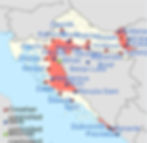C - 26 : Yugoslav Civil War 1991 - 2001
- hbanziger
- Jun 28, 2019
- 3 min read
The older amongst you may remember the civil war in Yugoslavia from 1991 to 2001 which followed the break-up of the republic after the fall of the Iron Curtain. It was a war that brought ethnic cleansing, genocide, mass rape and concentration camps back to Europe. With 140'000 casualties, 4.4 million refuges and 35'000 raped women and children, it was the most brutal conflict Europe had seen since 1945. International Humanitarian Law was breached and disregarded on a scale not seen before. It ended thanks to NATO's involvement which came late but eventually checked the Serbian aggression.

Yugoslavia was an artificial creation put together after WWI from the Kingdom of Serbia and the southern territories of the Habsburg Monarchy. Whilst the Serbian, Croatian and Slovenian languages differ not more than the Swiss dialects, the cultural background was very different. Serbs were Orthodox Christians with a thousand year old dream of Empire. Both the Slovenians and the Croatians were Catholic nations which favoured self-government and decentralisation. That Yugoslavia stayed united for over 70 years was primarily the achievement of Marshall Tito, the Croatian partisan leader who defeated the German Wehrmacht in WWII. As a Croatian and authoritarian, communist leader, he was able to balance Serbian ambition with the interests of the other nations. But affairs deteriorated after his death in 1980. When the Serbian leadership tried to centralise power in 1989 and the dialogue between the various parties broke down, Slovenia and Croatia declared independence in 1991. The then Yugoslav Prime Minister declared the secession illegal and ordered the Yugoslav People's Army (YPA) to "secure the integrity of the state". 70% of the YPA's officer corps was Serbian. Civil war ensued and lead to five related wars:
The 10-Day War in Slovenia in 1991 in which the Slovenian militia defeated the isolated units of the YPA
The Serbian - Croatian War from 1991 - 1995
The war in Bosnia from 1992 - 1995
The Kosovo war from 1998 - 1999
The insurgency of the Republic of North Macedonia in 2001
This is not the place to go into many details. Wikipedia has an excellent series of articles under the search word "Yugoslav Wars". I will focus on the Serbian - Croatian war instead which was fought along the route we will be sailing this summer.

The Serbian plan of attack was simple. Use the YPA's overwhelming air and tank forces to
Immediately occupy the parts of Croatia where Serbians were in the majority
Cut Dalmatia into three parts, isolate it from inland Croatia and remove it from the war theatre
Attack and retake Zagreb from the Serbian Mainland (main attack)
The plan worked well in the first few weeks but the decentralised and militia based structure of the Yugoslav Army gave the Croats an opening to organise resistance. The fact that the YPA systematically massacred Croatian units they had defeater (as in the town of Vukovar) stiffened the resistance of the remaining Croatian Forces. Eventually they were able to stop the YPA's advance. The YPA now moved to indiscriminate warfare against the Croatian population and started shelling villages and towns. In Dubrovnik over 60% of the historic old town was damaged. By early 1992, the Serbian effort had run out of steam and stalemate ensued. In 1992, a fragile armistice was signed along the occupied territories on the map (in red)

The brutal killing of civilians by Serb Forces led to a diplomatic breakthrough. First, Germany recognised Croatia in 1991. Most western nations followed a year later. With this, the door opened for building secretly a Croatian Army of 100'000 men equipped with modern weapons, bought from Eastern Europe nations which had thrown off Communist dictatorship three years earlier.
In late 1994, the new Croatian Army was ready and launched a massive counterattack to retake occupied territories. By summer 1995, the Serbs were defeated - partially due to NATO's intervention which denied the Serbian Army the use of its Air Force. The war was basically over. The Serbian population in Croatia was forced to flee. Ethnic cleansing was not just a tool used by the Serbs.
There are many memorials along the coast. We found them in Dubrovnik, Split, Sibenic and Zadar. Most of the war damage has been repaired. Towns and villages look pretty and inviting again. The scars in the souls of the people who had to go through this experience remain deep - you will hear them talk about it.



